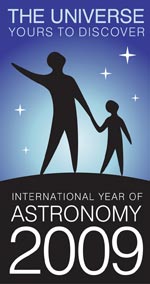Almost four decades in a few words
In March of 1977, after the conclusion of an astronomy course taught by Max Schreier PhD. in the Centro Portales (now, Centro Simón I. Patiño, part of Fundación Simón Patiño); a group of people among teachers, university students, and others; decided to form an institution devoted to astronomy activities the "Grupo de Astronomia Cochabamba" (GAC).
By the end of 1978 GAC and the astronomy club of "Centro Experimental Bolivia" (CEB), join together to improve the astronomical activities.
The first activity was a public exposition (coincident with the 100th anniversary of Albert Einstein Born) in middle of March 1979. The exposition named "Expokosmos 79", was totally done by them, copying some pictures from books, magazines, etc. Drawing schematics, making scale models, painting telescopic like images, 3D views of planets and satellites, etc. This kind of expositions was been repeated next years. Totally supported by member's pockets, and built form scratch was visited, entrance fee free, by more than two thousand people.
One year after, the idea of gather the efforts in one institution was a logical and smart decision, to avoid any confussion for the merged institutions a new name has adopted: Centro de Investigación y Estudio en Astronomía - Sigma del Octante (Centre for research and study in astronomy - Sigma Octantis); "Astronomía Sigma Octante" for short. Anyway, the cumbersome names not match our way to make things and we use, commonly, Astronomia Sigma Octante that emphasizes our activity: Astronomy; and followed by a good sounding name in Spanish, the name of a south star. Perhaps, like other amateurs in Bolivia, we have the chance to attach to our name words like: National, Boliviano and try to obligate to every people in Bolivia affiliate to our institution, like other Bolivian experiences; but we like to do science, not politics. We founded our activities on knowledge and work, not in cumbersome names to impress locals and foreign.
Systematic observations began, or continued previous observational works, like sunspots observations. Positional astronomy and other related activities, computer programming applications to astronomy, and so on, started.
Since the middle 80's a new stage of work began, with more emphasis in: mathematical, computational and observational activities. We get many achievements and provide the society with information based on our calculations and work.
Previous to Internet arrival to Bolivia, ASO becomes the unique institution in Bolivia with capability to generate information by itself, v. gr., calculating the local circumstances for Solar Eclipses for a lot of cities and towns on Bolivia; visibility conditions for many comets, and teaching and explaining about many astronomical phenomena by social media. The newspapers ask for many articles and we can give advice to population on many topics related with astronomy and celestial phenomena observation.
Also, we expend efforts in activities like astronomy courses, radio programs and magazines collaborations, issuing astronomical bulletins, astronomical observations and lectures for schools and universities, and so on. In many opportunities we have astronomical activities (observations and lectures) far from the city in country towns, attending rural schools in cooperation with the "Librerías Populares del Centro Pedagógico y Cultural Simón I. Patiño". The list of activities is very long.
 English
English  Español
Español